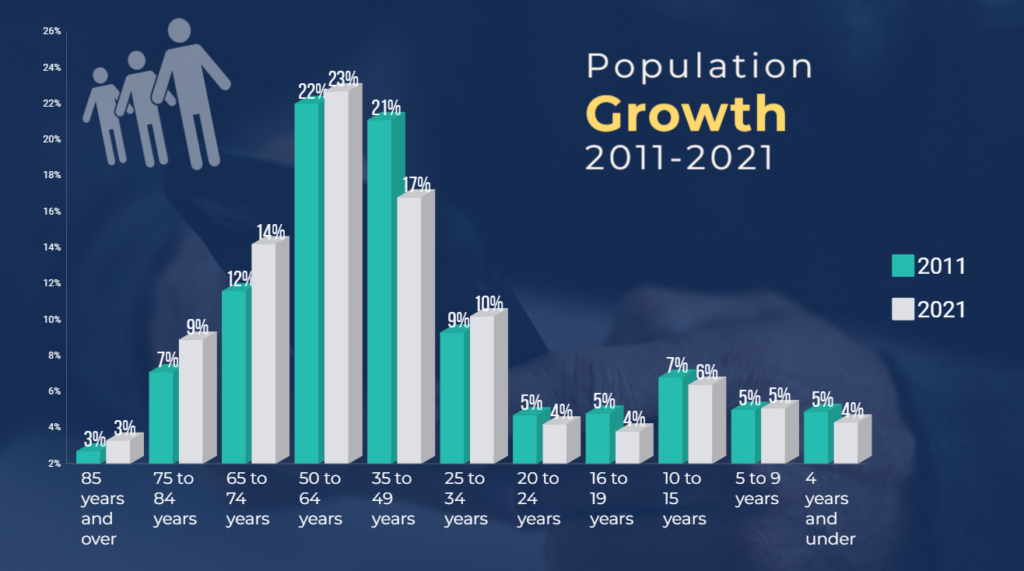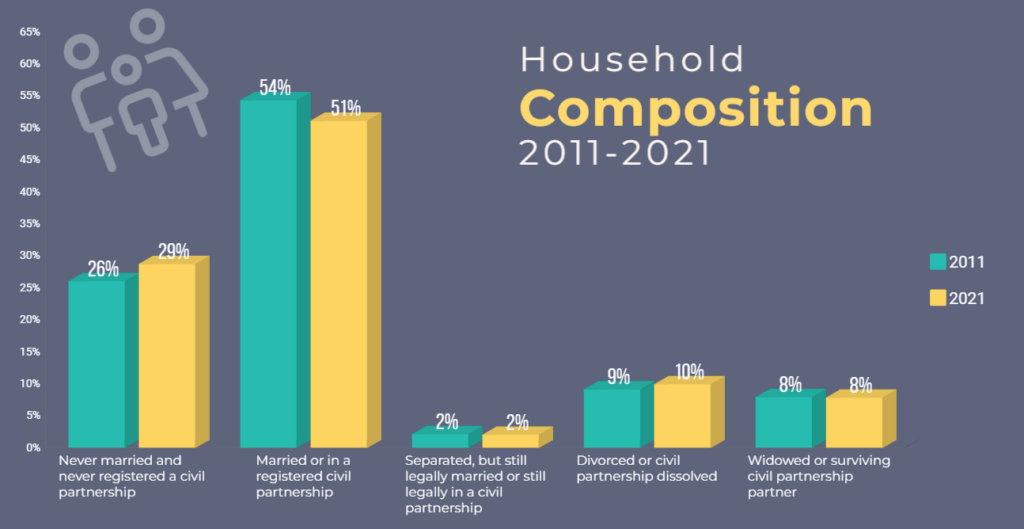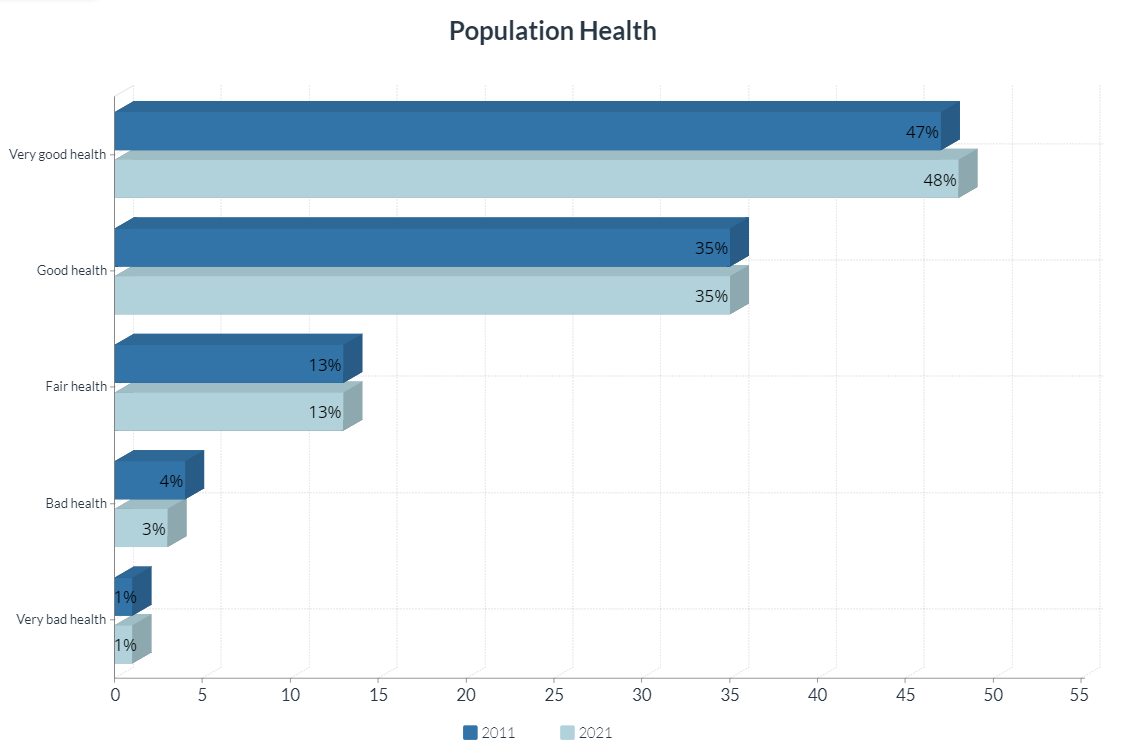
The East Riding of Yorkshire is located in the north of England on the East Coast approximately 200 miles from Edinburgh and London. The East Riding of Yorkshire comprises of 26 Wards, 171 Parishes, 210 Lower Super Output Areas (LSOAs) and 1,114 Output Areas (OAs), covering an area of approximately 240,768 hectares (or 930 square miles). The coastline stretches for 53 miles from Bempton to Spurn Point.
In 2021, the population was estimated at 342,200 (ONS Population Estimates 2021), living in 152,066 households (2021 Census). By 2041, the population is predicted to reach 360,033 (2021 ONS Population Projections), which is a lower rate of growth than the Yorkshire and Humber region and the overall increase for England. This is in part due to the number of residents who leave the area to access higher education and who, once qualified, do not return, and as a consequence there is a lower proportion of people of working age. People of working age (16-64) account for 57.7% of the total population, whilst those of pesionable age account for 26.5%, and is predicted to grow at a faster rate than elsewhere in the UK – this has significant implications for the health and care sector. There has been an increase of 26.7% in people aged 65 years and over, a decrease of 4.7% in people aged 15 to 64 years, and a decrease of 2.2% in children aged under 15 years. (ONS Census Population Change, 2021). This profile will inevitably place considerable additional pressures on the provision of health and social care services and workforce availability.

As the balance of our population changes, we will also see more and more people needing help to live at home. We expect to see demand for social care for people aged over 65 increase significantly in the next 10 to 15 years. This is a serious challenge to our public services; there will simply not be enough younger people, or resources, to look after this number of older people in the same way as we do now, therefore our new adult social care delivery model and market shaping activity is crucial to managing this situation.
In 2011, the ONS classified the East Riding as being approximately 93% rural by area and 44% rural by population. This results in a low population density of approximately 1.4 people per hectare. This presents a unique and challenging landscape for providing Adult Social Care, with client groupings being split between sparse rural areas and town and village clusters. As more and more clients choose to manage their own care and stay in their own homes for longer, it is increasing the burden on home care support.
The Council is committed, through our Your Life, Your Way programme to support and empower people to take charge of their own care and stay in their homes for as long as they feel able. By working with partners within the Health and Care sector we want to ensure that there is a robust infrastructure in place to support existing need and nurture new and exciting proposals to meet need and support people’s independence.
Understanding our unique needs
The ageing demographic of the East Riding means that the provision of adult social care is of particular importance, but the size and areas of rurality of the county can make the delivery of effective services more challenging. There will be an increased tax burden to support public sector provision; however, market opportunity for the private sector to deliver products and services will also expand, offering opportunity for growth or new providers to enter the market. Market shaping and subsequent commissioning can provide a major route for this and there is always opportunity for business development to occur independently of Council plans.
In 2017, the 65+ population was 25.4% of the total population of the East Riding (compared with 18.4% in the Yorkshire & the Humber region and 18 .0% in England). This is expected to increase by 34% by 2043 which is 7.6% higher than the figures recorded in 2020 and 12% above the expected England average of 22%. This profile will inevitably place considerable additional pressures on the provision of health and social care services and workforce availability.
As the balance of our population changes, we will also see more and more people needing help to live at home. We expect to see demand for social care for people aged over 65 increase significantly in the next 10 to 15 years. This is a serious challenge to our public services; there will simply not be enough younger people, or resources, to look after this number of older people in the same way as we do now, therefore our new adult social care delivery model and market shaping activity is crucial to managing this situation.
In 2011, the ONS classified the East Riding as being approximately 93% rural by area and 44% rural by population. This results in a low population density of approximately 1.4 people per hectare. This presents a unique and challenging landscape for providing Adult Social Care, with client groupings being split between sparse rural areas and town and village clusters. As more and more clients choose to manage their own care and stay in their own homes for longer, it is increasing the burden on home care support.
The Council is committed, through our Your Life, Your Way programme to support and empower people to take charge of their own care and stay in their homes for as long as they feel able. By working with partners within the Health and Care sector we want to ensure that there is a robust infrastructure in place to support existing need and nurture new and exciting proposals to meet need and support people’s independence.

Geography
Between the last two censuses (held in 2011 and 2021), the population of East Riding of Yorkshire increased by 2.4%, from around 334,200 in 2011 to around 342,200 in 2021.
The population here increased by a smaller percentage than the overall population of Yorkshire and The Humber (3.7%), and by a smaller percentage than the overall population of England (up 6.6% since the 2011 Census).
Population
Between the last two censuses, the average (median) age of East Riding of Yorkshire increased by four years, from 45 to 49 years of age.
This area had a higher average (median) age than Yorkshire and The Humber as a whole in 2021 (40 years) and a higher average (median) age than England (40 years).
The median age is the age of the person in the middle of the group, meaning that one half of the group is younger than that person and the other half is older.
The number of people aged 65 to 74 years rose by just over 9,700 (an increase of 25.1%), while the number of residents between 35 and 49 years fell by around 12,900 (18.3% decrease).
Fall in employment
Of East Riding of Yorkshire residents aged 16 years and over, 52.9% said they were employed (excluding full-time students) in 2021, down from 55.5% in 2011.
The decrease in the percentage of people aged 16 years and over (excluding full-time students) who were employed was greater in East Riding of Yorkshire (2.6 percentage points) than across Yorkshire and The Humber (1.1 percentage points, from 54.5% to 53.5%). Across England, the percentage fell by 0.8 percentage points, from 56.5% to 55.7%.
* This information is from the 2021 Census which took place during the coronavirus (COVID-19) pandemic, a period of rapid and unparalleled change; the national lockdown, associated guidance and furlough measures will have affected the labour market and the ability to measure it.
Change in work hours
In 2021, 10.2% of East Riding of Yorkshire residents aged 16 years and over and in employment said they worked 15 hours or less per week. This figure decreased from 10.5% in 2011.
East Riding of Yorkshire saw Yorkshire and The Humber’s joint second-largest fall (alongside Sheffield) in the percentage of people aged 16 years and over and in employment who said they usually worked 15 hours or less per week. This area had the region’s ninth highest percentage of people aged 16 years and over and in employment who said they usually worked 15 hours or less per week.
Working hours may have been affected by the coronavirus (COVID-19) pandemic.
Ethnicity
In 2021, 1.1% of East Riding of Yorkshire residents identified their ethnic group within the “Asian, Asian British or Asian Welsh” category, up from 0.9% in 2011. The 0.2 percentage-point change was the largest increase among high-level ethnic groups in this area.
In 2021, 97.4% of people in East Riding of Yorkshire identified their ethnic group within the “White” category (compared with 98.1% in 2011), while 0.9% identified their ethnic group within the “Mixed or Multiple” category (compared with 0.7% the previous decade).
The percentage of people who identified their ethnic group within the “Other” category (“Arab” or “Any other ethnic group”) increased from 0.2% in 2011 to 0.4% in 2021.
There are many factors that may be contributing to the changing ethnic composition of England and Wales, such as differing patterns of ageing, fertility, mortality, and migration. Changes may also be caused by differences in the way individuals chose to self-identify between censuses.
Housing
East Riding of Yorkshire saw Yorkshire and The Humber’s largest percentage-point fall in the proportion of households including a couple but no children (from 22.0% in 2011 to 20.0% in 2021).
Despite the decrease, East Riding of Yorkshire was in the highest 10% of English local authority areas for the share of households including a couple but no children in 2021.
Household Composition
Of East Riding of Yorkshire residents aged 16 years and over, 28.8% said they had never been married or in a civil partnership in 2021, up from 26.1% in 2011.
In 2021, just over one in two people (51.2%) said they were married or in a registered civil partnership, compared with 54.4% in 2011. The percentage of adults in East Riding of Yorkshire that had divorced or dissolved a civil partnership increased from 9.2% to 10.0%.
The increase in the percentage of people aged 16 years and over who had never been married or in a civil partnership was greater across Yorkshire and The Humber (3.8 percentage points, from 33.9% to 37.7%) than in East Riding of Yorkshire (2.7 percentage points). Across England, the percentage increased by 3.3 percentage points, from 34.6% to 37.9%.
These figures include same-sex marriages and opposite-sex civil partnerships in 2021, neither of which were legally recognised in England and Wales in 2011. Same-sex marriages have been legally recognised in England and Wales since 2014 and opposite-sex civil partnerships have been recognised since 2019.
Home Status (private/ rented)
Of East Riding of Yorkshire households, 16.9% rented privately in 2021, up from 13.7% in 2011.
In 2021, just over 1 in 11 households (9.4%) lived in socially rented housing, compared with 9.1% in 2011. The percentage of East Riding of Yorkshire households that owned their home (outright or with a mortgage or loan) decreased from 75.3% to 73.1%.
The increase in the percentage of privately-rented homes in East Riding of Yorkshire (3.2 percentage points) was similar to the increase across Yorkshire and The Humber (3.5 percentage points, from 15.9% to 19.4%). Across England, the percentage increased by 3.6 percentage points, from 16.8% to 20.5%.
Health
In 2021, 48.4% of East Riding of Yorkshire residents described their health as “very good”, increasing from 47.0% in 2011. Those describing their health as “good” remained at 34.5%. These are age-standardised proportions.
Age-standardised proportions are used throughout this section. They enable comparisons between populations over time and across geographies, as they account for differences in the population size and age structure.
The proportion of East Riding of Yorkshire residents describing their health as “very bad” remained 1.1%, while those describing their health as “bad” fell from 3.8% to 3.5%.
These data reflect people’s own opinions in describing their overall health on a five point scale, from very good to very bad.
Census 2021 was conducted during the coronavirus (COVID-19) pandemic. This may have influenced how people perceived and rated their health, and therefore may have affected how people chose to respond.
Disability
In 2021, 6.7% of East Riding of Yorkshire residents were identified as being disabled and limited a lot.This figure decreased from 8.1% in 2011. These are age-standardised proportions.
Age-standardised proportions are used throughout this section. They enable comparisons between populations over time and across geographies, as they account for differences in the population size and age structure.
In 2021, around 1 in 10 people (10.0%) were identified as being disabled and limited a little, compared with 9.7% in 2011. The proportion of East Riding of Yorkshire residents who were not disabled increased from 82.2% to 83.3%.
The decrease in the proportion of residents who were identified as being disabled and limited a lot was greater across Yorkshire and The Humber (1.7 percentage points, from 9.9% to 8.2%) than in East Riding of Yorkshire (1.4 percentage points). Across England, the proportion fell by 1.6 percentage points, from 9.1% to 7.5%.
Census 2021 was undertaken during the coronavirus (COVID-19) pandemic. This may have influenced how people perceived their health status and activity limitations, and therefore may have affected how people chose to respond.
Caution should be taken when making comparisons between 2011 and 2021 because of changes in question wording and response options.
Unpaid Care
In 2021, 4.4% of East Riding of Yorkshire residents (aged five years and over) reported providing up to 19 hours of unpaid care each week. This figure decreased from 7.3% in 2011. These are age-standardised proportions.
Age-standardised proportions are used throughout this section. They enable comparisons between populations over time and across geographies, as they account for differences in the population size and age structure.
The decrease in the proportion of people (aged five years and over) providing up to 19 hours of weekly unpaid care in East Riding of Yorkshire (2.9 percentage points) was similar to the decrease across Yorkshire and The Humber (2.7 percentage points, from 7.1% to 4.4%). Across England, the proportion fell by 2.8 percentage points, from 7.2% to 4.4%.
Census 2021 was undertaken during the coronavirus (COVID-19) pandemic. This may have influenced how people perceived and managed their provision of unpaid care, and therefore may have affected how people chose to respond.
Caution should be taken when making comparisons between 2011 and 2021 because of changes in question wording and response options.
Source: Office for National Statistics – 2011 Census and Census 2021













